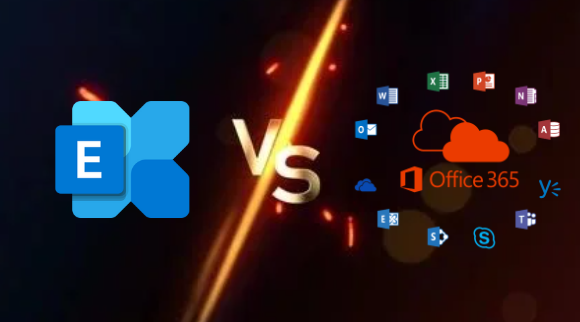Currently, Microsoft 365 and Exchange Server stand as popular choices. However, deciding between them can present a perplexing dilemma. Plus, most of the users are opting for O365, over Exchange Server but why? To know On-Premises Exchange vs Office 365, which is best you have to read this article carefully.
Let’s start our discussion with a brief introduction of the same.
An Overview: On-Premises Exchange vs Office 365
Microsoft Exchange Server has been a go-to for email and calendar services in business. Its extensive market share and continuous enhancements provide better control, security, and management.
In recent years, cloud platforms have surged, led by Microsoft’s Office 365. This suite offers tailored plans for individuals, students, businesses, and enterprises. Office 365 integrates Exchange with a suite of cloud services like SharePoint Online, MS Office, Skype for Business, and more, enriching its ecosystem. Even O365 is better than G Suite also.
Next, we will the comparison with the help of your company’s requirements to choose which one is the best for you.
Get to Know What Your Business Needs
To find the right service for you, here are key points. They’ll help you decide between On-Premises Exchange vs Office 365.
- What’s the overall expense of handling on-site resources?
- What’s your organization’s industry type?
- How much do you spend on hardware and software?
- What advantages come with on-premises or Online Exchange Servers?
- What’s your expected duration of application use?
These points can guide your choice of the ideal platform. Next, we’ll delve deeper, exploring the pros and cons of Exchange Server and O365.
Exchange vs Office 365 Pros and Cons
If you are searching about the advantages of the M365 over Exchange Server. Then your search ends here as there are key benefits to opting for the Online Exchange. With them, you can easily understand why Exchange Server is widely used by users.
- More Users, Fewer Worries: Exchange in the Cloud matches the features of on-site Exchange, offering 50 GB of online email storage accessible across devices. You buy licenses as per user needs.
- Cost-Efficient Choices: Office 365 provides varied plans. Each license offers Office Online or Suite installation on multiple devices, plus free services like SharePoint and Skype for Business, saving costs compared to On-Premise Exchange.
- Data Safety Assurance: Microsoft prioritizes user data security, offering multifunctional authentication for email security. They ensure data safety during outages or disasters. Plus, it supports the backup and recovery policy to ensure data continuity, if your data may be lost.
- Seamless Updates: Subscribers receive the latest Office 365 enhancements, boosting productivity with smooth, automatic updates without IT intervention.
Disadvantages of M365
Below mentioned are the limitations of the On-Premise Server, which the users need to be aware of:
- Loss of Administrative Control: With Office 365, organizations relinquish control over data stored on Microsoft servers, whose locations are undisclosed. This raises concerns about data jurisdiction and law compliance in different countries.
- Complex Migration Process: The migration steps from On-Premise Exchange to Office 365 are intricate, often causing challenges and leading some corporations to abort the migration due to a lack of support.
- Application Integration Constraints: Integrating third-party apps with Office 365 lacks flexibility. Automatic updates often occur without user control, potentially affecting system compatibility.
- On-Premise Exchange Server: This refers to in-house servers within a company, the traditional method of managing Exchange. Notable differences between On-Premise Exchange and Office 365 include administrative control and data location.
As we read out the advantages and the disadvantages of the Online Exchange. Moreover, in the next section, we will discuss some more information about Exchange Server in the context of On-Premises Exchange vs Office 365.
Benefits of Exchange Server: On-Premises Exchange vs Office 365
There are several advantages provided by On-Premise Server, and a few of them are listed below:
- Administrative Control: On-Premise Exchange grants full control over hardware and software configurations. Maintenance, from installation to upgrades, is solely managed by the organization.
- Enhanced Customization: Compared to Office 365, On-Premise Exchange allows more flexible integration with third-party applications. Local hosting facilitates smoother integration with other applications.
- Data Storage Responsibility: Administrators bear responsibility for all service modifications. Users can decide backup timings and storage locations, ensuring data is stored on backup tapes, online drives, or remote servers.
De-merits of the On-Premise Server
- Data Vulnerability: On-Premise Exchange poses data loss risks in the absence of a Disaster Data Recovery plan, especially if a disaster strikes, potentially leading to complete data deletion.
- Costly Investment: Unlike Office 365, On-Premise Exchange demands substantial investments in hardware, software, licensing, and workforce. Beyond the initial investment, ongoing updates are essential to stay aligned with evolving technology trends.
- Security Management: Exchange administrators must actively configure network and system security protocols to counter threats. If internal staff lacks expertise, organizations may need to hire professionals for these tasks.
So, after thoroughly exploring the detailed Exchange vs Office 365 pros and cons, it’s evident that Office 365 outweighs On-Premise Server. This information often sparks curiosity among users about migrating from Office 365 to Exchange Server. The next section delves into the transition process between these platforms.
What’s Next?
If you want to migrate your entire data from Exchange Server to M365. Then, you have to opt for SysTools Exchange to Office 365 Migration Tool. With this, you can easily execute your transition process without facing any hassle. Plus, it supports to export of Exchange Server 2010, 2013, 2016, and 2019 mailboxes.
If you are thinking why are we talking about a specific tool, while there are many other software like this on the internet? So, the answer is because of its advanced features even IT experts are opting for this utility. It offers many features like a “Date Filter” to export specific data, and “Delta Migration” to migrate newly arrived information.
Furthermore, you can access a demo version of this solution. For full benefits, consider upgrading to the complete version.
Wrapping Up
This guide explains the comparison of On-Premises Exchange vs Office 365 in detail. Plus, we understand the Exchange vs Office 365 pros and cons, which will help to choose which one is best for us. Also, after reading the entire article we concluded that Office 365 is better than On-Premise Server.


